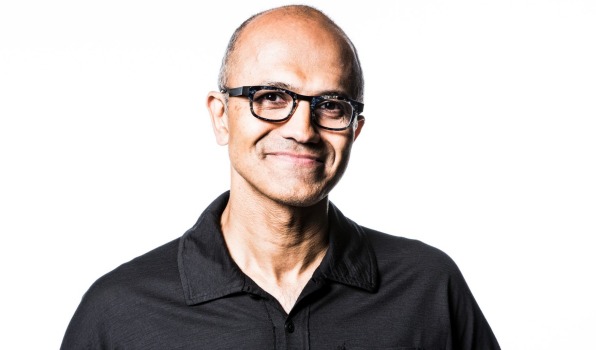Microsoft was founded by Bill Gates and Paul Allen on the fourth of April in 1975. They started the company with the vision: ‘A computer on every desk and in every home’. Something what was seen as very ambitious during that time, but nowadays we could not even imagine not having one. (Bright, 2015); (Microsoft, 2017)
In 2014, Satya Nadella became the new CEO of Microsoft and with this the vision and mission of Microsoft changed as well. No longer is the company striving to have ‘a computer on every desk and in every home’, but the new vision is to build ‘A mobile-first, cloud-first world’ and to ‘Empower every person and every organisation on the planet to achieve more’. (Kim, 2015)
Nadella: ‘Our strategy is to build best-in-class platforms and productivity services for a mobile-first, cloud-first world. Our platforms will harmonize the interests of end users, developers and IT better than any competing ecosystem or platform. We will realize our mission and strategy by investing in three interconnected and bold ambitions.
- Reinvent productivity and business processes
- Build the intelligent cloud platform
- Create more personal computing
These ambitions utilize a unique set of assets that span productivity services, cloud platform, our device platform and our family of devices. There is an explicit path dependence on how we achieve the “inter-connectedness” between the various elements of our strategy to gain momentum.’ (Kim, 2015); (Microsoft, 2017)
So, Microsoft has changed from a product company to a service company. And in order to realize its mission and strategy, Azure (the Microsoft cloud) is probably the most important service it currently offers. (Sawhney, 2016)
But by entering the cloud computing market, she has taken on the battle with Google and Amazon. And although, from a market share perspective, Amazon is still dominating the cloud computing market with its Amazon Web Services (AWS), but Google and Microsoft are showing higher growth rates in the first quarter of 2017. So the question arises: is Microsoft going to be able to continue this growth and dethrone Amazon? (Titcomb, 2016); (Miller, 2017)
Well, if we have to believe Nadella, Microsoft’s ‘AI supercomputer’ is going to set it apart from its competitors. He is convinced that its competitors are not that advanced in working out how software could interact with people on a seemingly human level. And because of that fact, that Azure will become the first artificial intelligence supercomputer in the world. (Smith, 2016); (Rathnam, 2017)
But like Microsoft, Google and Amazon have also seen the value AI can bring to their cloud and they have taken actions as well. Google has been working on advanced machine learning plans to get more customers on its cloud platform and is now also making plans to further its AI plans by entering an open-source library (Tensorflow). Similarly, Amazon is making contributions to its cloud as well. It has revealed it is going to offer AI-based services, genomics, molecular modeling, and more. Therefore, Microsoft has to move fast if its wants to be dominant in the AI market and beat Google and Amazon in ‘the battle of the cloud’. (Rathnam, 2017)
But one thing is for sure: Microsoft is cool again.
Bright, P. (2015) Microsoft has a new mission statement, and it’s basically the same as its old one [online] Arstechnica, Available at: https://arstechnica.com/information-technology/2015/06/microsoft-has-a-new-mission-statement-and-its-basically-the-same-as-its-old-one/ [Accessed 10 October 2017]
Kim, E. (2015) Microsoft has a strange new mission statement [online] Business Insider, Available at: http://www.businessinsider.com/microsoft-ceo-satya-nadella-new-company-mission-internal-email-2015-6?international=true&r=US&IR=T [Accessed 10 October 2017]
Microsoft (2017) Facts About Microsoft [online] Microsoft, Available at: https://news.microsoft.com/facts-about-microsoft [Accessed 10 October 2017]
Miller, R. (2017) AWS won’t be ceding its massive market share lead anytime soon [online] Techcrunch, Available at: https://techcrunch.com/2017/07/28/aws-wont-be-ceding-its-massive-market-share-lead-anytime-soon/ [Accessed 10 October 2017]
Rathnam, L. (2017) Microsoft’s lofty cloud goal: make azure the first AI supercomputer [online] Techgenix, Available at: http://techgenix.com/azure-the-first-ai-supercomputer/ [Accessed 10 October 2017]
Sawhney, M. (2016) Putting products into services [online] HBR, Available at: https://hbr.org/2016/09/putting-products-into-services [Accessed 10 October 2017]
Smith, P. (2016) How Satya Nadella is making Microsoft cool again, and taking on Apple and Amazon [online] Financial Review, Available at: http://www.afr.com/technology/technology-companies/microsoft/how-satya-nadella-is-making-microsoft-cool-again-and-taking-on-apple-and-amazon-20161118-gssfb1 [Accessed 10 October 2017]
Titcomb, J. (2016) Cloud wars: Google, Amazon and Microsoft battle to own the future of computing [online] Telegraph, Available at: http://www.telegraph.co.uk/technology/2016/03/25/cloud-wars-google-amazon-and-microsoft-battle-to-own-the-future/ [Accessed 10 October 2017]


